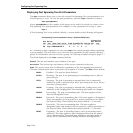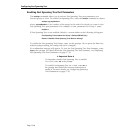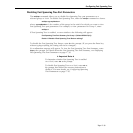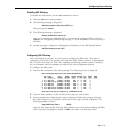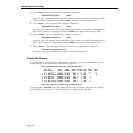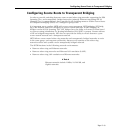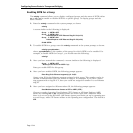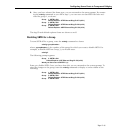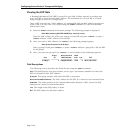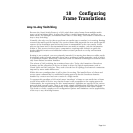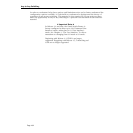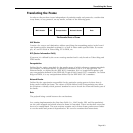
Configuring Source Route to Transparent Bridging
Page 17-44
Enabling SRTB for a Group
The srtbcfg command allows you to display configured groups and the status of SRTB (either
on or off), and to enable or disable SRTB for a specific group. To display groups and the
status of SRTB:
1. Enter the
srtbcfg command at the system prompt, as shown
srtbcfg
A screen similar to the following is displayed:
Group 1: SRTB is OFF
Group 2: SRTB is ON
Default Explorer: STE Ethernet Ring ID: 291(x123)
Group 3: SRTB is ON
Default Explorer: ARE Ethernet Ring ID: 561(x231)
/VLAN SRTB>
2. To enable SRTB for a group, enter the srtbcfg command at the system prompt, as shown:
srtbcfg <groupNumber>
where <groupNumber> is the number of the group for which SRTB is to be enabled. For
example, to enable SRTB for Group 1, you would enter the following:
srtbcfg 1
3. Once you have entered the command, a screen similar to the following is displayed:
Group 1: SRTB is OFF
Would you like to turn on SRTB ? (n) :
Enter y to enable SRTB for this group.
4. Once you have enabled SRTB, the following prompt appears:
Enter Ring ID for Ethernet segment(s) (0 - 0x0)? :
Create a ring ID for the Ethernet segment assigned to this group. This number can be in
decimal or hexadecimal form, but it must be unique. For example, if you have a token
ring segment with a ring ID of 2, then you could not assign the number 2 to an Ethernet
ring ID.
5. Once you have assigned an Ethernet token ID, the following prompt appears:
Send Multicast/unknown frames as STE or ARE ? (STE) :
Choose to employ Spanning Tree Explorer (STE) frames or All Route Explorer (ARE)
frames by entering
ste or are. Explorer frames are sent to learn MAC addresses when
there is no record in the RIF table. ARE frames ignore port blocks set up by spanning tree
to avoid loops, while STE frames adhere to the spanning tree configuration. The default is
STE.



